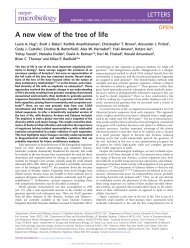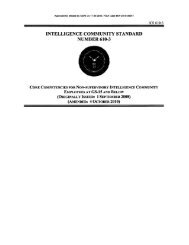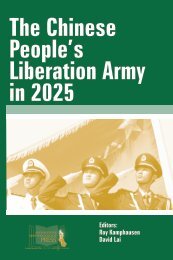The Joint Force in a Contested and Disordered World
JCS-JOE-2035
JCS-JOE-2035
You also want an ePaper? Increase the reach of your titles
YUMPU automatically turns print PDFs into web optimized ePapers that Google loves.
direct assault on the U.S. homel<strong>and</strong> by traditionally organized, equipped, <strong>and</strong> comm<strong>and</strong>ed military<br />
forces operat<strong>in</strong>g at the direction of a national political authority is probably far lower than most<br />
other threats, it has not gone away. Foreign powers may focus strikes or raids on targets which<br />
result <strong>in</strong> larger systemic effects aga<strong>in</strong>st U.S. economic or power projection capabilities.<br />
Some sub- or transnational groups see the United States as underwrit<strong>in</strong>g world order <strong>and</strong> believe<br />
that deliver<strong>in</strong>g catastrophic damage to the U.S. homel<strong>and</strong> will serve to divert U.S. military power<br />
from <strong>in</strong>terdict<strong>in</strong>g them overseas. VEO <strong>and</strong> irregular/special operations forces (SOF) networks are<br />
likely to have the capacity to organize, tra<strong>in</strong>, <strong>and</strong> equip with<strong>in</strong> the U.S. itself. <strong>The</strong>se non-state<br />
actors may launch attacks with<strong>in</strong> the homel<strong>and</strong> to prevent the United States from <strong>in</strong>terfer<strong>in</strong>g with<br />
their goals <strong>and</strong> objectives. Although this strategy has historically failed, its frequent appearance<br />
suggests that weaker adversaries still believe they can deliver a blow aga<strong>in</strong>st the homel<strong>and</strong> that<br />
may keep the United States from engag<strong>in</strong>g.<br />
Military Competitive Space<br />
“…we can expect that future attacks will aim at both large-scale casualties <strong>and</strong> symbolic<br />
targets…[they seek] high body counts, go after iconic targets, <strong>and</strong> cause economic<br />
damage. <strong>The</strong> terrorists will cont<strong>in</strong>ue to demonstrate tactical adaptability, which will make<br />
it difficult to plan security measures around past threats or a few threat scenarios.<br />
Terrorists <strong>in</strong>novate.” 20<br />
Military competition with<strong>in</strong> this context will revolve around the ability of adversaries to <strong>in</strong>fluence,<br />
deter, <strong>and</strong> coerce the United States through the credible threat of violence aga<strong>in</strong>st its homel<strong>and</strong><br />
<strong>and</strong> citizens. <strong>The</strong> frequency <strong>and</strong> array of adversary deterrent operations are likely to <strong>in</strong>crease, to<br />
<strong>in</strong>clude snap nuclear exercises, bomber flights, <strong>and</strong> strategic reconnaissance overflights <strong>in</strong>to U.S.<br />
ADIZs as typically conducted by Russia. Ch<strong>in</strong>a may conduct similar global deterrent operations<br />
through maritime presence operations near U.S. territories <strong>and</strong> bases throughout the Pacific. From<br />
time to time, even smaller regional powers such as Iran <strong>and</strong> North Korea may attempt deterrent<br />
missions.<br />
<strong>The</strong> <strong>Jo<strong>in</strong>t</strong> <strong>Force</strong> will need an array of capabilities to complicate or defeat the deterrent strategies<br />
of adversaries. <strong>The</strong>se will <strong>in</strong>clude aerospace awareness sensors <strong>and</strong> layered antiballistic missile<br />
systems, but also maritime capabilities to counter patrols by adversary submar<strong>in</strong>es <strong>and</strong> long-range<br />
unmanned submersibles used aga<strong>in</strong>st underwater <strong>in</strong>frastructure <strong>in</strong> U.S. territorial waters <strong>and</strong><br />
Exclusive Economic Zones. Creat<strong>in</strong>g these capabilities will naturally <strong>in</strong>crease the <strong>in</strong>centives for<br />
the United States to divert already scarce defense resources away from its own global power<br />
projection capabilities to focus more on homel<strong>and</strong> defense measures.<br />
Adversaries may also attempt to disrupt the ability of the United States to conduct overseas military<br />
operations through attacks on major nodes of the global trade <strong>and</strong> logistics network such as large<br />
conta<strong>in</strong>er ports or major airports. Some adversaries might also attempt to attack military bases <strong>and</strong><br />
facilities to disproportionately degrade the ability of the United States to generate, deploy, <strong>and</strong><br />
ma<strong>in</strong>ta<strong>in</strong> the <strong>Jo<strong>in</strong>t</strong> <strong>Force</strong>. <strong>The</strong> development of small, smart, cheap, autonomous, long-range, <strong>and</strong><br />
highly-capable systems operat<strong>in</strong>g <strong>in</strong> the air, l<strong>and</strong>, sea, <strong>and</strong> undersea environments may further<br />
20<br />
RAND Corporation, <strong>The</strong> Lessons of Mumbai, (2009), p. 21<br />
26











